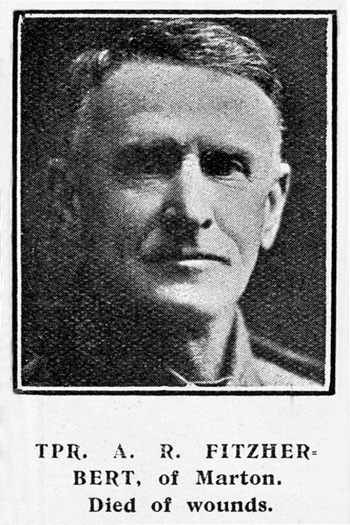
Arthur Richard Fitzherbert, No. 7/1724, 6th (Manawatu) Squadron, Wellington Mounted Rifles.
Died of wounds, 27 March 1917.
Born at Tissington Hall in Derbyshire, England, in 1853, Arthur Richard Fitzherbert was the second son of Lieutenant-Colonel Richard Henry Fitzherbert and his wife, Susan. When he was 19, Arthur left England to settle in New Zealand, buying land near Marton which he farmed. In 1881 he married local woman Mary Lucy Marshall; the couple had four children. A fit man of average height with hazel eyes, Arthur was active in the local community, taking part in sport and amateur dramatics.
61-year-old Arthur – two decades older than the cut-off age for enlistment – was desperate to fight when war broke out in 1914. He eventually managed to pass as a man of 40 and joined the Canterbury Mounted Rifles the following August. Arthur left New Zealand with the 7th reinforcements and arrived in Egypt in November.
In January 1916 Arthur transferred into the Wellington Mounted Rifles and joined the squadron in which his eldest son, also Arthur, was serving. He became a well-loved member of his regiment, known for his unfailing cheerfulness and determination to fight. He refused assignment to clerical work on several occasions, cheerfully saying that he had enlisted to fight.
In April 1916 the Mounted Rifles became part of the Egyptian Expeditionary Force (EEF), tasked with fighting the Ottoman Empire in the Middle East. By early 1917 they had pushed the Ottomans out of the Sinai Desert and reached the borders of Palestine. Their next goal was Gaza.
On 26 March 1917 the EEF launched their attack. 63-year-old Arthur was wounded early in the advance. He continued to fight, but was forced to seek medical attention after being wounded a second time. On his way to a dressing station, Arthur had stopped to help a wounded comrade when he was hit by shrapnel. He was treated in the field but died of his wounds.
Arthur is buried at the Deir El Belah War Cemetery in Gaza and is also remembered at St John’s Anglican Church at Tutu Totara, near Marton. After his death, Lieutenant-Colonel Charles Guy Powles of the Mounted Rifles wrote that Arthur had ‘the heart of a boy. He was loved by all who knew him and was an inspiration to the whole brigade. … He died as he would have wished in the midst of battle with his rifle in his hand.’ [1]
Further information
Auckland War Memorial Museum Online Cenotaph record - Arthur Fitzherbert
Commonwealth War Graves Commission record - Arthur Fitzherbert
'Marton', Wanganui Herald, 9 November 1874, p. 2
'Wanganui Amateur Athletic Club', Wanganui Chronicle, 22 August 1878, p. 2
'The Athletic Meeting', Wanganui Herald, 3 October 1878, p. 2
'Marton Amateur Dramatic Society', Wanganui Herald, 29 September 1890, p. 2
'The Yeomen of the Guard', Wanganui Herald, 15 February 1894, p. 2
'On Service', Evening Post, 6 June 1917, p. 2
'Roll of Honour', Auckland Star, 7 July 1917, p. 6
Marton First World War memorial
Lieutenant-Colonel Charles Guy Powles, The New Zealanders in Sinai and Palestine, Whitcombe & Tombs, Auckland, 1922
Rangitikei Heritage Group, Rangitikei remembers: stories from World War 1, 2014 [DVD]
[1] Lieutenant-Colonel Charles Guy Powles, The New Zealanders in Sinai and Palestine, Whitcombe & Tombs, Auckland, 1922, p. 95.

Community contributions